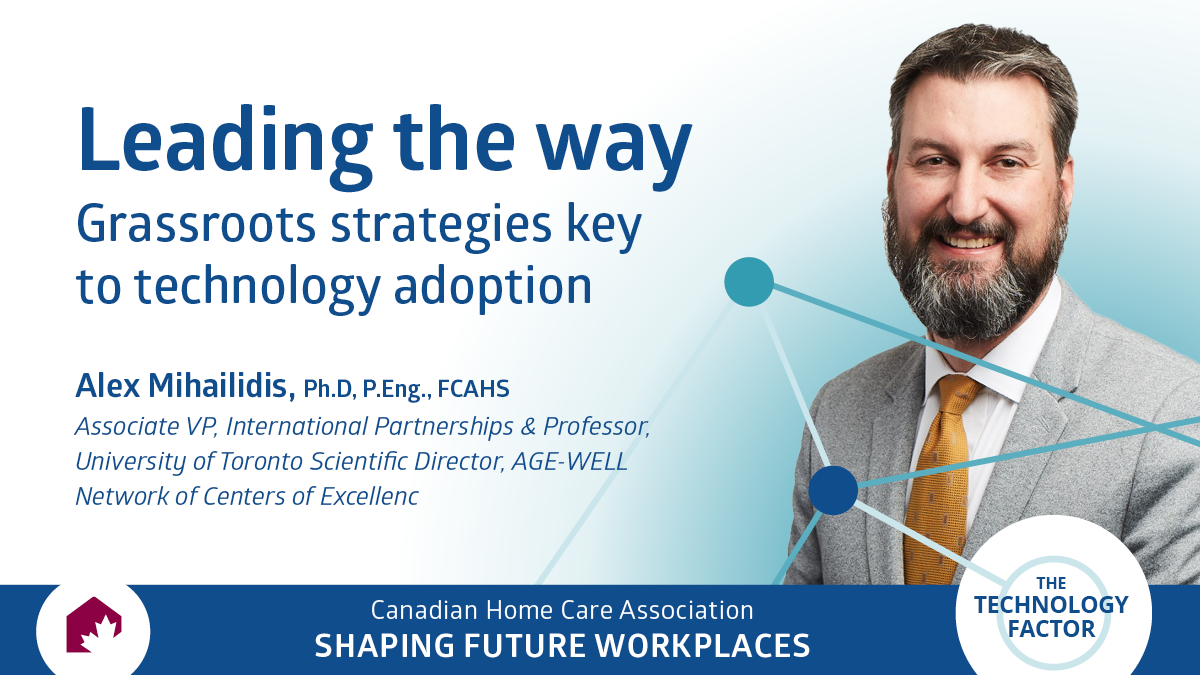Leading the way
Grassroots strategies key to technology adoption
Innovative technology abounds and it goes without saying that the impact is felt virtually everywhere, by everyone. Smartphones are ubiquitous and older people are the leading purchasing consumer group for these devices in Canada. There is a wide variety of apps on peoples’ phones and tablets which have become more accepted as tools to help with all manner of activities including exercise, happiness, medication adherence, and socialization. There are social robots – such as Alexa or Google Homes and service robots ranging from pet feeders to vacuum systems. Smart devices and smart homes are emerging as older people and their families look for reasonable ways to remain safe and supported at home.
Smart homes have the potential to greatly enhance the way people live and interact with their environment. With the integration of smart technology, consumers can control and automate various systems and devices in their homes such as heating, lighting, security, and appliances. Potential benefits of smart homes include increased energy efficiency and improved safety and security of a home. Smart security systems can detect and alert homeowners of potential intrusions or fires and can be remotely monitored and controlled through a smartphone app. Additionally, smart homes and devices can monitor the patterns of living and then apply artificial intelligence to look for changes or try to predict changes in people’s health so the right interventions can proactively be implemented.
Service robots to carry and fold the laundry or take the garbage to the curb will soon be commercially available and increasingly affordable. People already socialize with Alexa or Google and that technology on a stand is essentially a robot. Using social robots enables connection to friends, family and care teams and means that people can access social and medical support from home. Despite the assertion that humans would not bond to robots, where tested in the field, consumers suggest otherwise, with some going so far as giving the “robot” a hat or a sweater.
Traditionally, home care has been considered a high touch service. However, the emerging technologies and shortage of staff are driving a new approach. Technology alone cannot solve all the needs of older adults. Well educated and prepared home care providers will need to be supported by technology and enabled by policy to deliver the right mix of “tech and touch” to the consumer. With a robust application of technology, home care can be a hybrid model of 1) tech to trigger when physical resources need to be deployed; 2) in-person care services; 3) and support from family and friends.

Technology is the easy part. The sweet spot is at the intersection of service delivery, technology, and policy and as the image shows, supported by education. Notwithstanding, technology developers need consumers to be engaged in design development and educated in how to maximize functionality. Many people only use a small fraction of the capabilities of the technology with which they interact daily. For example, most people primarily use smartphones for texting, making phone calls, and using social media, even though smartphones are capable of much more.
The home care workforce needs to be educated on how to use technology and operate in a smart environment as part of their practice. They need to see the technology as part of their service offering and learn to trust it.
Policymakers must create an environment where the right mix of home care services can be delivered, trusting the clinicians and their governing bodies to have standards by which to practice.
Governments could also support demonstration sites – homes for technology and home care that are designed and equipped with various types of technology and home care services to showcase their capabilities and potential benefits. These homes can be used to educate and inform consumers, as well as professionals, about the latest technology and home care services available, and how they can be used to improve the way people live and age in place. They can be open to the public, allowing visitors to see and experience the technology and services in a real-world setting. They can also be used for research and testing of new products and services. Demonstration homes can play an important role in promoting the use of technology and home care services for older adults and people with disabilities.
As with social shifts in the past, consumers need to drive the demand for change. Boomers have confronted stereotypes around many social norms including aging and have been quick to adopt new technologies. Their insistence on autonomy and convenience will drive up innovation and drive down the cost of technology. The sales pitch for new technology to address the current crisis in home care needs to be amplified direct to the consumer. Governments and home care programs need to take note and prepare.



